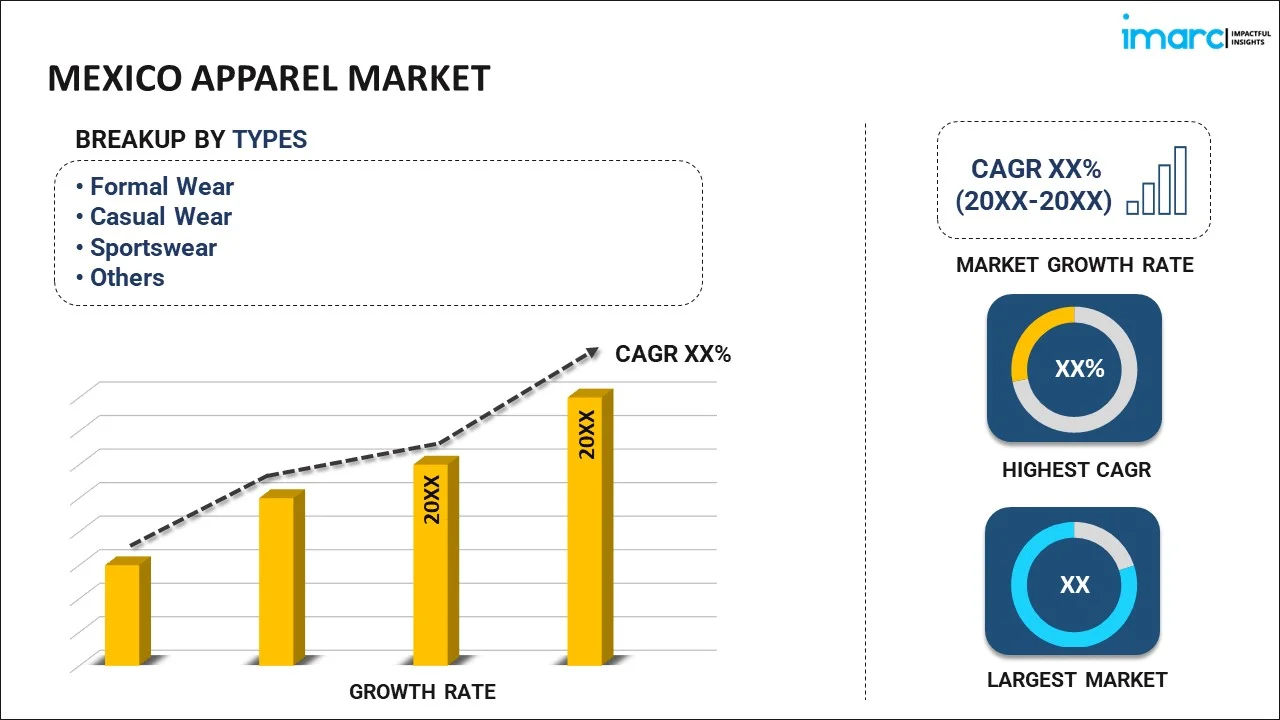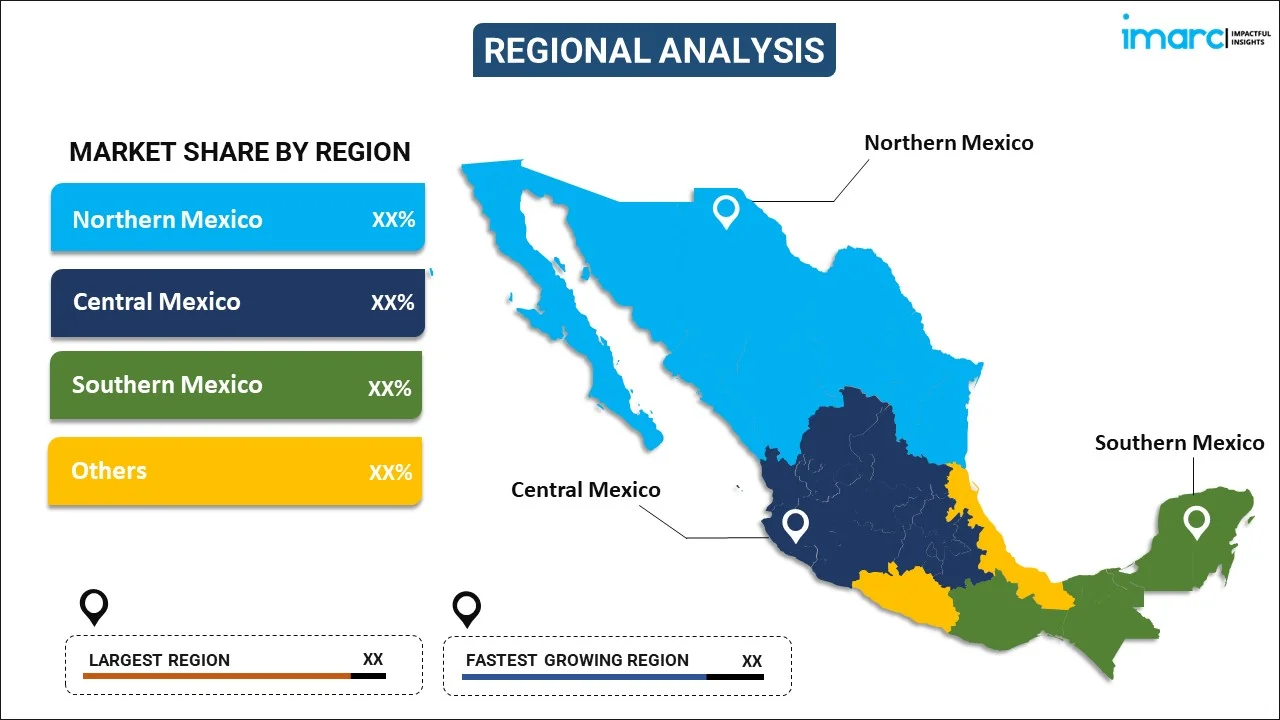
Mexico Apparel Market Report by Type (Formal Wear, Casual Wear, Sportswear, Nightwear, and Others), Type of Fiber (Man-Made Fibers, Cotton Fibers, Animal-Based Fibers, Vegetable Based Fibers), End User (Men, Women, Children), Distribution Channel (Online, Offline), and Region 2025-2033
Market Overview:
Mexico apparel market size reached USD 23.0 Billion in 2024. Looking forward, IMARC Group expects the market to reach USD 38.2 Billion by 2033, exhibiting a growth rate (CAGR) of 5.30% during 2025-2033. The increasing advancements in fabric technology, manufacturing processes, and the use of innovative materials, which contribute to the development of new and improved apparel products, attracting consumers seeking unique and high-quality items, are primarily driving the regional market.
|
Report Attribute
|
Key Statistics
|
|---|---|
|
Base Year
|
2024
|
|
Forecast Years
|
2025-2033
|
|
Historical Years
|
2019-2024
|
|
Market Size in 2024
|
USD 23.0 Billion |
|
Market Forecast in 2033
|
USD 38.2 Billion |
| Market Growth Rate 2025-2033 | 5.30% |
Mexico Apparel Market Insights:
- Major Market Drivers: Rising income levels, adoption of urban lifestyle, and changing fashion trends are prompting more frequent purchases of clothing. There is a growing trend of influence by global fashion, social media, and celebrity culture, which are all collectively driving consumer demand across both mass as well as premium apparel segments, propelling Mexico apparel market share.
- Key Market Trends: Sustainability, digital retailing uptake, and athleisure growth are transforming the buying behavior of consumers. The demand for sustainable materials, multi-use apparel, and frictionless online shopping is highly popular among younger generations who place high value on convenience, comfort, and moral manufacturing in fashion consumption.
- Competitive Landscape: Mexico apparel market size is extremely dynamic with a combination of local and international players competing on speed-to-market, diversity of style, and brand loyalty. Personalized shopping, influencer partnerships, and locally adapted trends are increasingly becoming critical strategies to stay connected with customers and differentiate themselves.
- Challenges and Opportunities: Increasing production expenses, volatile raw material prices, and logistics problems are issues that still linger. Further, businesses that adopt digitalization, provide eco-friendly alternatives, and venture into underserved rural or mid-city markets can open up new sources of growth and brand reach.
Apparel refers to clothing or garments worn by individuals for practical, cultural, or fashion purposes. It encompasses a wide range of items, including shirts, pants, dresses, outerwear, and accessories like hats and shoes. Apparel serves not only as a basic necessity for protection and modesty but also plays a significant role in expressing one's identity, style, and cultural affiliations. The fashion industry drives the design, production, and distribution of apparel, responding to evolving trends and consumer preferences. The materials used in apparel can vary, from natural fibers like cotton and wool to synthetic fabrics such as polyester. In contemporary society, the apparel industry has become a phenomenon, influencing economies, promoting creativity, and reflecting societal values through the diverse array of clothing choices available to individuals.
Mexico Apparel Market Trends:
Emergence of Sustainable and Ethical Fashion
Sustainable clothing is growing to dominate the Mexico apparel market outlook as consumers increasingly become more environmentally conscious. Local and international brands are launching green collections with organic cotton, recycled textiles, and biodegradable packaging. The industry is also seeing an upswing in slow fashion with its focus on longevity and sustainable sourcing. This is a response to evolving lifestyles and shopping patterns, especially among young and urban consumers. Trained by social media and sustainability movements, Mexican consumers are turning towards transparent brands that resonate with environmental principles. This has generated a quantifiable change in the Mexico apparel market demand for responsibly sourced garments. With this increasing focus on circularity and traceability, the market is set to witness lasting change. Sustainable clothing is no longer niche—it is highly becoming a fundamental aspect of the market trends, paving the way towards inclusive development across retail segments.
Development of Digital-First and Omni-Channel Retailing
The speed of digital adoption keeps transforming the market analysis. As internet penetration and smartphone access increase, consumers are moving toward online channels for purchasing apparel. This has resulted in the rise of new digital-native retail models and better omni-channel strategies like click-and-collect, virtual try-ons, and AI-based personalization. Social commerce via channels such as TikTok and Instagram is also shaping consumer behavior, particularly among millennials and Gen Z. These shifts are driving Mexico apparel market growth to a significant extent, as instant customer service, variety, and convenience drive purchases. Conventional retailers are re-shaping their strategies to remain competitive, incorporating digital channels to enhance engagement and conversion. This convergence of offline and online interactions is a characteristic element of the emerging trends, reflecting a direction toward integration, technology-enabled retail environments in both urban and semi-urban areas.
Growth of Premium and Athleisure Segments
Mexico apparel market forecast reports strong growth in premium and athleisure wear, driven by increasing disposable incomes and shifting lifestyle trends. For instance, in November 2024, Onitsuka Tiger and Patou introduced a joint apparel and footwear collection in Mexico, enhancing luxury streetwear products and driving premium segment expansion in the Mexico apparel market. Moreover, consumers are placing greater emphasis on high-quality, fashionable, and comfortable clothing for casual wear as well as for fitness. Athleisure specifically has turned into a lifestyle movement instead of a fashion trend, marrying aesthetics with performance. This shifting preference is driving performance wear, yoga wear, and high-end basics growth. With the growing convergence of fashion and wellness, health-conscious consumers are asking for clothing that is good for both form and function. The increase in gym membership and urban fitness culture further fueled the demand. All these changes are revolutionizing the market share, compelling brands to experiment with fabric technology, comfort, and fashion. The intensifying popularity of these segments highlights an important change in consumer trends, placing premium and athleisure as crucial forces within the wider Mexico apparel market trends.
Mexico Apparel Market Segmentation:
IMARC Group provides an analysis of the key trends in each segment of the market, along with forecasts at the country level for 2025-2033. Our report has categorized the market based on type, type of fiber, end user, and distribution channel.
Type Insights:

To get more information on this market, Request Sample
- Formal Wear
- Casual Wear
- Sportswear
- Nightwear
- Others
The report has provided a detailed breakup and analysis of the market based on the type. This includes formal wear, casual wear, sportswear, nightwear, and others.
Type of Fiber Insights:
- Man-Made Fibers
- Cotton Fibers
- Animal-Based Fibers
- Vegetable Based Fibers
A detailed breakup and analysis of the market based on the type of fiber have also been provided in the report. This includes man-made fibers, cotton fibers, animal-based fibers, and vegetable based fibers.
End User Insights:
- Men
- Women
- Children
The report has provided a detailed breakup and analysis of the market based on the end user. This includes men, women, and children.
Distribution Channel Insights:
- Online
- Offline
A detailed breakup and analysis of the market based on the distribution channel have also been provided in the report. This includes online and offline.
Regional Insights:

- Northern Mexico
- Central Mexico
- Southern Mexico
- Others
The report has also provided a comprehensive analysis of all the major regional markets, which include Northern Mexico, Central Mexico, Southern Mexico, and Others.
Competitive Landscape:
The market research report has also provided a comprehensive analysis of the competitive landscape in the market. Competitive analysis such as market structure, key player positioning, top winning strategies, competitive dashboard, and company evaluation quadrant has been covered in the report. Also, detailed profiles of all major companies have been provided.
Latest News and Developments:
- In January of 2024, Spanish clothing brands Pdpaola, Blue Banana, and Hoff moved into Mexico, indicating increasing Mexico-Spain commercial relations. Pdpaola opened in Palacio de Hierro in Mexico City, Hoff opened 15 franchise outlets, and Blue Banana launched new outdoor fashionwear, an indicator of increasing retail investment in Latin America.
- In June 2024, Balenciaga launched its debut store in Cancún at La Isla Shopping Village, marking luxury segment expansion in the Mexico clothing market. The 580 m² store includes ready-to-wear, footwear, and accessories to match increasing demand for premium fashion as well as growing international brand footprint in the country's clothing retail environment.
- In June 2024, TJX ventured into the Mexican apparel market through a joint venture with Grupo Axo, acquiring a 49% stake in its off-price retail business. The transaction involves more than 200 stores operating under Promoda, Reduced, and Urban Store brands, capturing increased demand for cheap fashion and increasing foreign investment in Mexico's retail sector.
Mexico Apparel Market Report Coverage:
| Report Features | Details |
|---|---|
| Base Year of the Analysis | 2024 |
| Historical Period | 2019-2024 |
| Forecast Period | 2025-2033 |
| Units | Billion USD |
| Scope of the Report | Exploration of Historical Trends and Market Outlook, Industry Catalysts and Challenges, Segment-Wise Historical and Future Market Assessment:
|
| Types Covered | Formal Wear, Casual Wear, Sportswear, Nightwear, Others |
| Types of Fiber Covered | Man-Made Fibers, Cotton Fibers, Animal-Based Fibers, Vegetable Based Fibers |
| End Users Covered | Men, Women, Children |
| Distribution Channels Covered | Online, Offline |
| Regions Covered | Northern Mexico, Central Mexico, Southern Mexico, Others |
| Customization Scope | 10% Free Customization |
| Post-Sale Analyst Support | 10-12 Weeks |
| Delivery Format | PDF and Excel through Email (We can also provide the editable version of the report in PPT/Word format on special request) |
Key Benefits for Stakeholders:
- IMARC’s industry report offers a comprehensive quantitative analysis of various market segments, historical and current market trends, market forecasts, and dynamics of the Mexico apparel market from 2019-2033.
- The research report provides the latest information on the market drivers, challenges, and opportunities in the Mexico apparel market.
- Porter's five forces analysis assist stakeholders in assessing the impact of new entrants, competitive rivalry, supplier power, buyer power, and the threat of substitution. It helps stakeholders to analyze the level of competition within the Mexico apparel industry and its attractiveness.
- Competitive landscape allows stakeholders to understand their competitive environment and provides an insight into the current positions of key players in the market.
Key Questions Answered in This Report
The apparel market in the Mexico was valued at USD 23.0 Billion in 2024.
The Mexico apparel market is projected to exhibit a CAGR of 5.30% during 2025-2033, reaching a value of USD 38.2 Billion by 2033.
Growing disposable income, fast urbanization, and increasing fashion awareness among Mexico's youth are major growth drivers of the Mexico apparel market. Rising e-commerce penetration, global brand entry, and athleisure and fast-fashion demand also fuel market growth. Strategic retail partnerships and local marketing are also strengthening brand visibility and consumer engagement in various demographics.
Need more help?
- Speak to our experienced analysts for insights on the current market scenarios.
- Include additional segments and countries to customize the report as per your requirement.
- Gain an unparalleled competitive advantage in your domain by understanding how to utilize the report and positively impacting your operations and revenue.
- For further assistance, please connect with our analysts.
 Request Customization
Request Customization
 Speak to an Analyst
Speak to an Analyst
 Request Brochure
Request Brochure
 Inquire Before Buying
Inquire Before Buying




.webp)




.webp)












